Abstract
CPAP should be considered the first line of treatment in patients with moderate to severe obstructive sleep apnoea. In our centre in Sydney this generally means patients with more than 20 apnoea/hypopnoeas per hour with repeated dips in oxyhaemoglobin saturation and usually some symptomatology. Despite this first line role of nasal CPAP, recent objective studies question whether earlier enthusiastic reports on adherence to CPAP are correct. The role of technical innovations in new CPAP machines in improving usage remains to be tested. The "drop out" rate from physician selection for a CPAP trial to highly compliant user is certainly more than 50% of patients. What happens to these patients? Data from some studies suggest that surgical treatments are used, at least in the USA, but in all probability many of these patients remain untreated. The challenge in the next decade is either to improve CPAP devices to increase usage in this group or to develop other treatment options. The role of intensive inhospital "acclimatisation" to CPAP also has yet to be objectively tested. It is unclear whether "intelligent" CPAP will make huge inroads in increasing the number of patients who accept CPAP trials, prescriptions, or compliance. It will have minimal impact on patients with mask problems or claustrophobia or those who feel that CPAP is inconvenient. There is a high likelihood that it will reduce technologist workload during CPAP titration studies. "Intelligent" CPAP may help to reduce total overnight mouth leakage and therefore reduce nasal side effects. The current expense of developing such devices will mean that they are unlikely to supersede much cheaper standard "one pressure" CPAP machines in the next few years.
Full text
PDF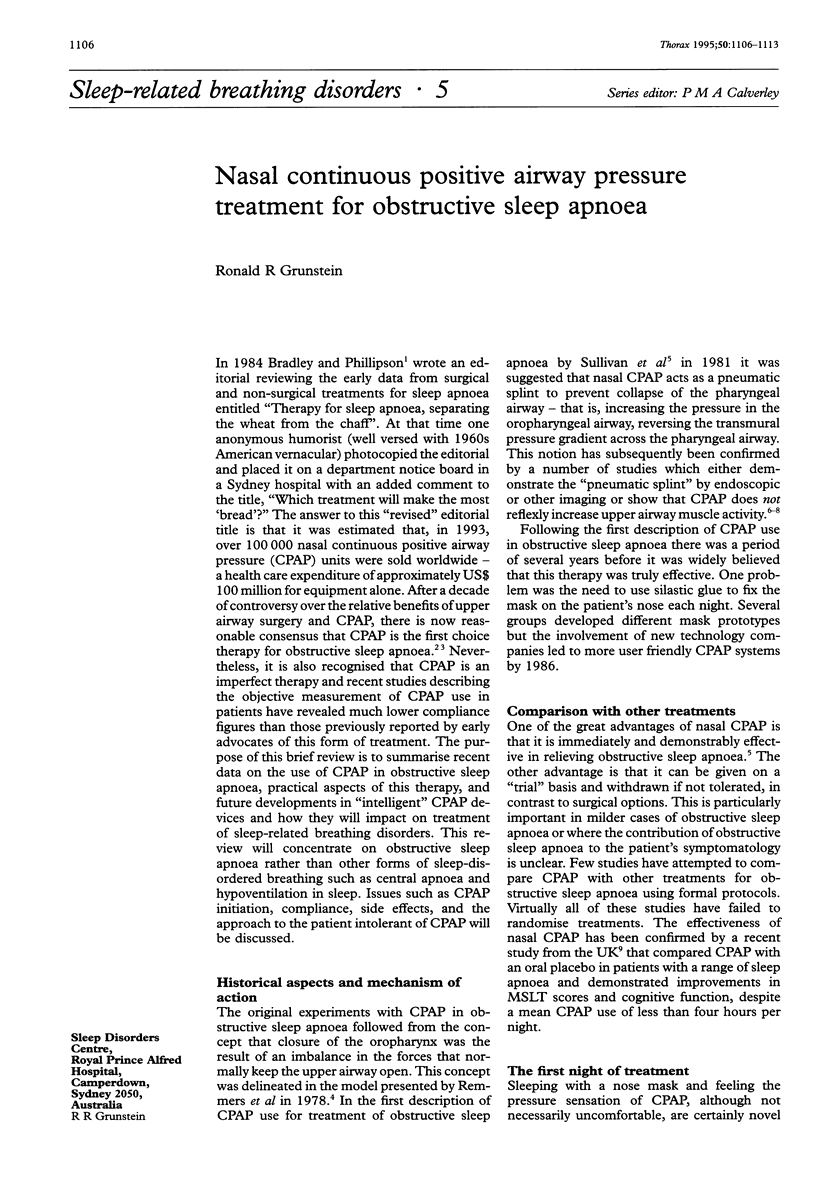
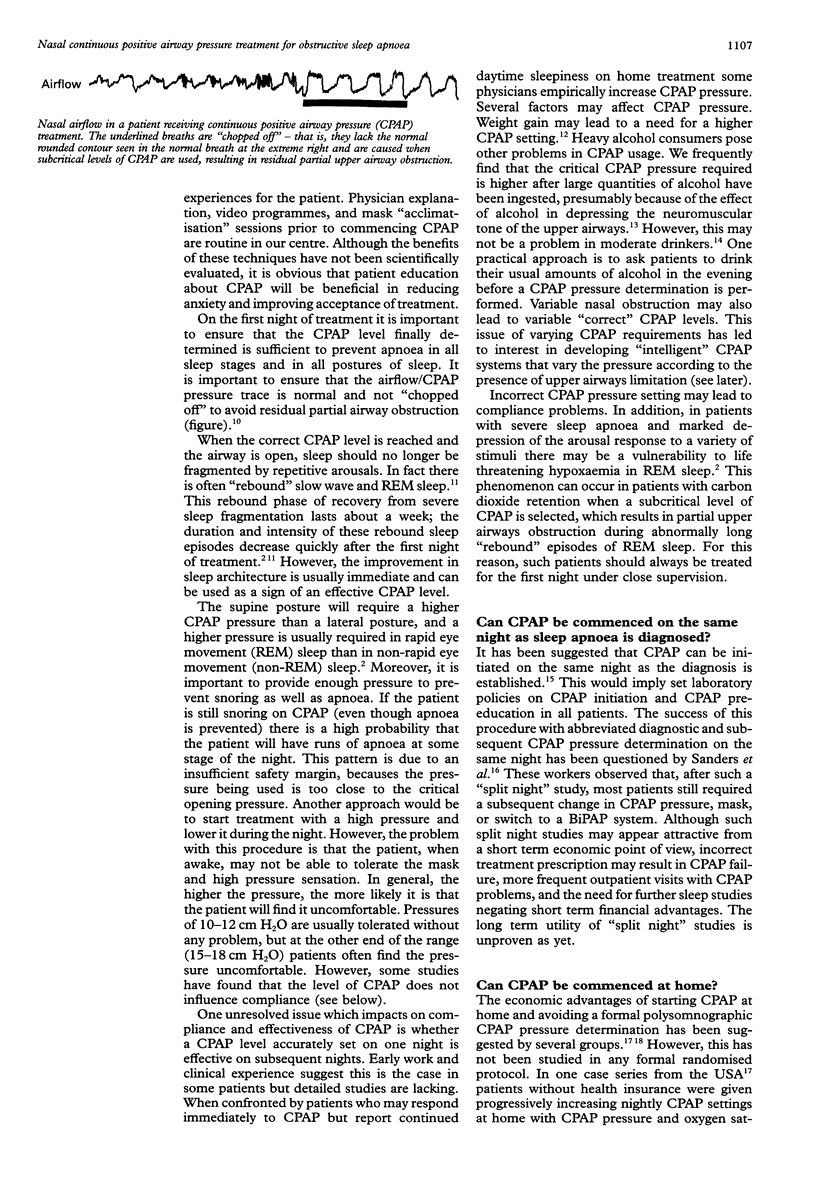
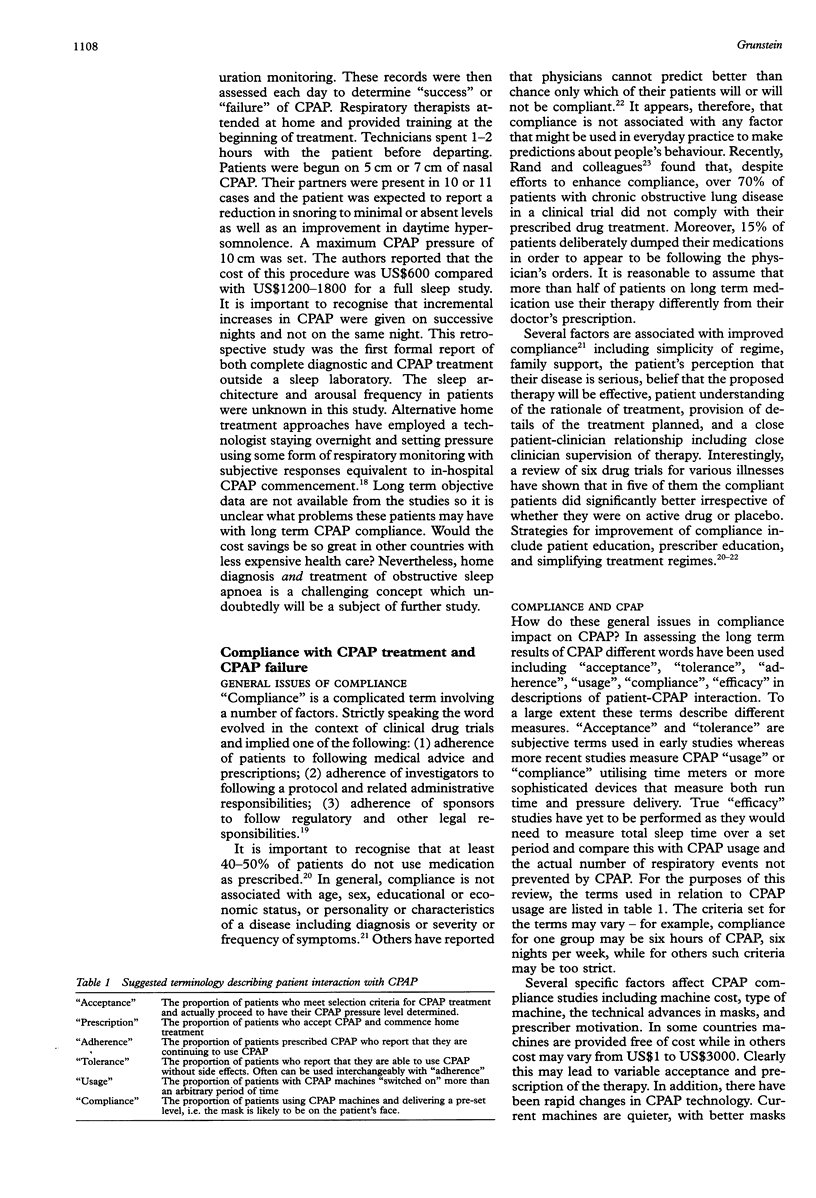
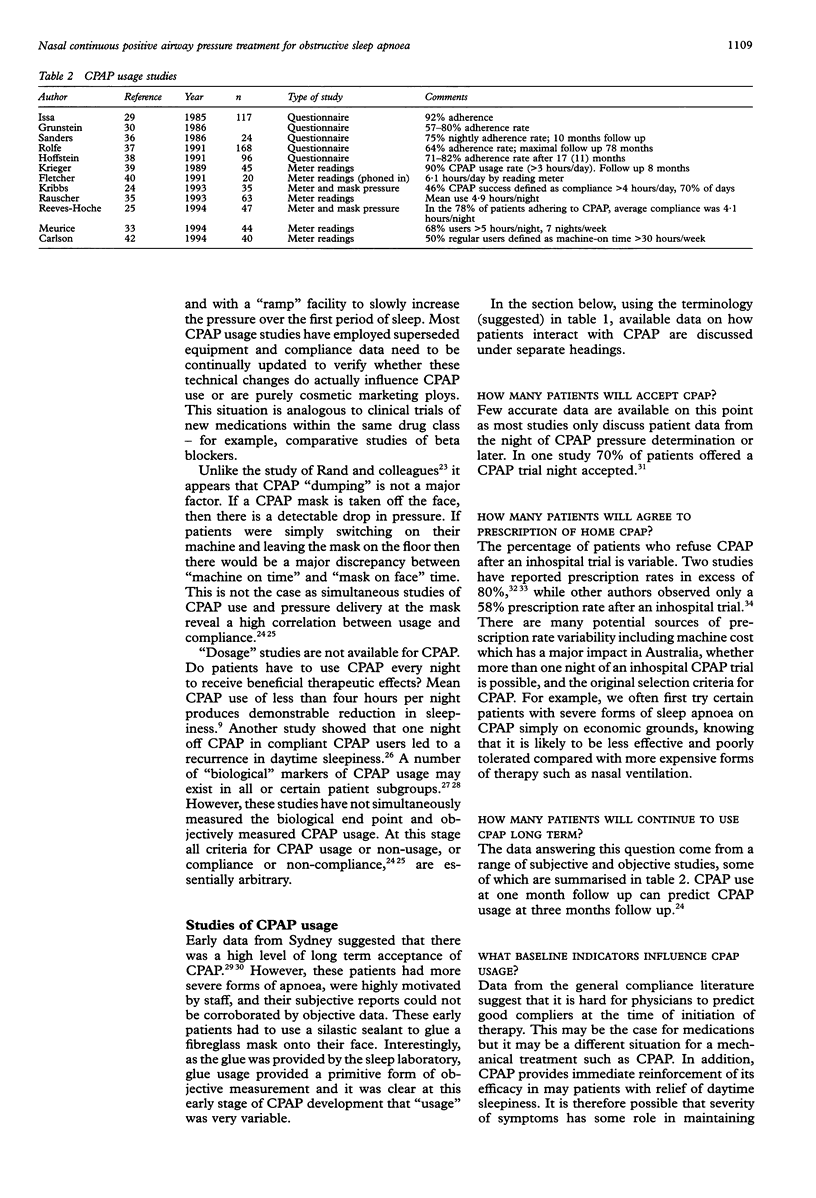
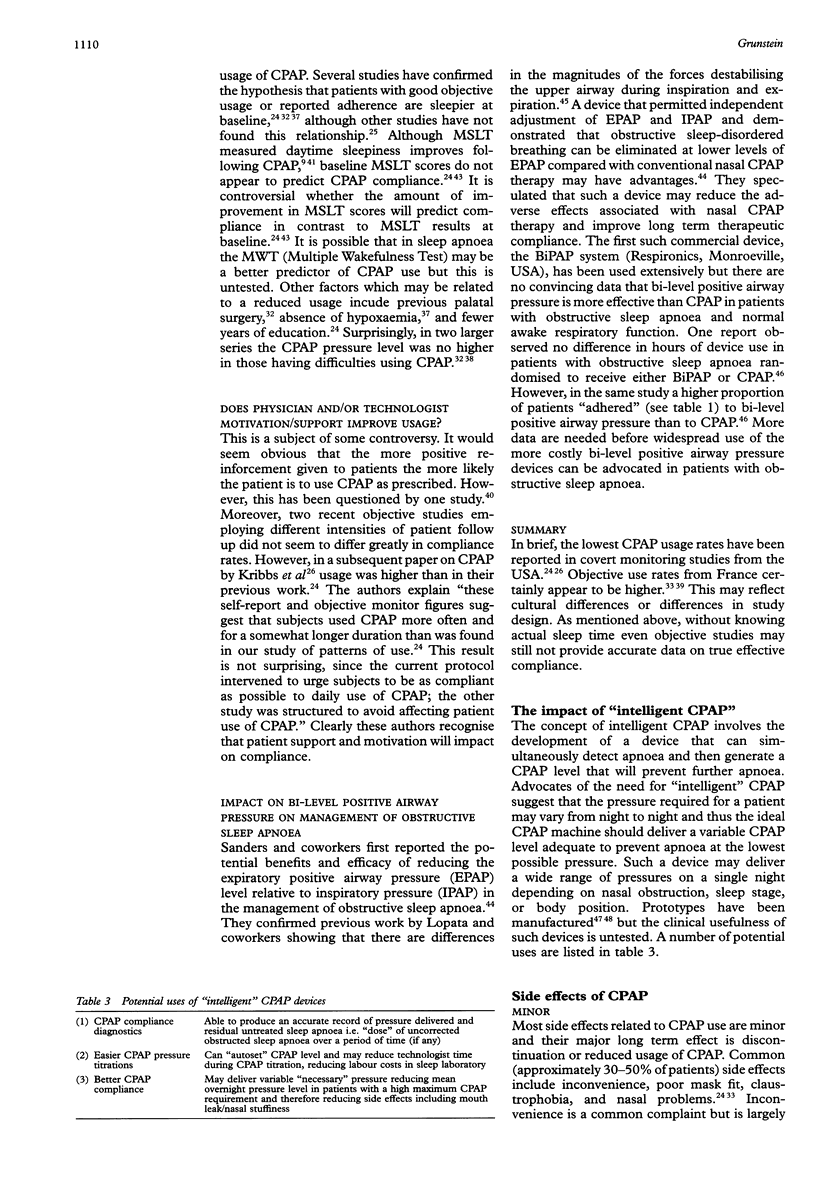
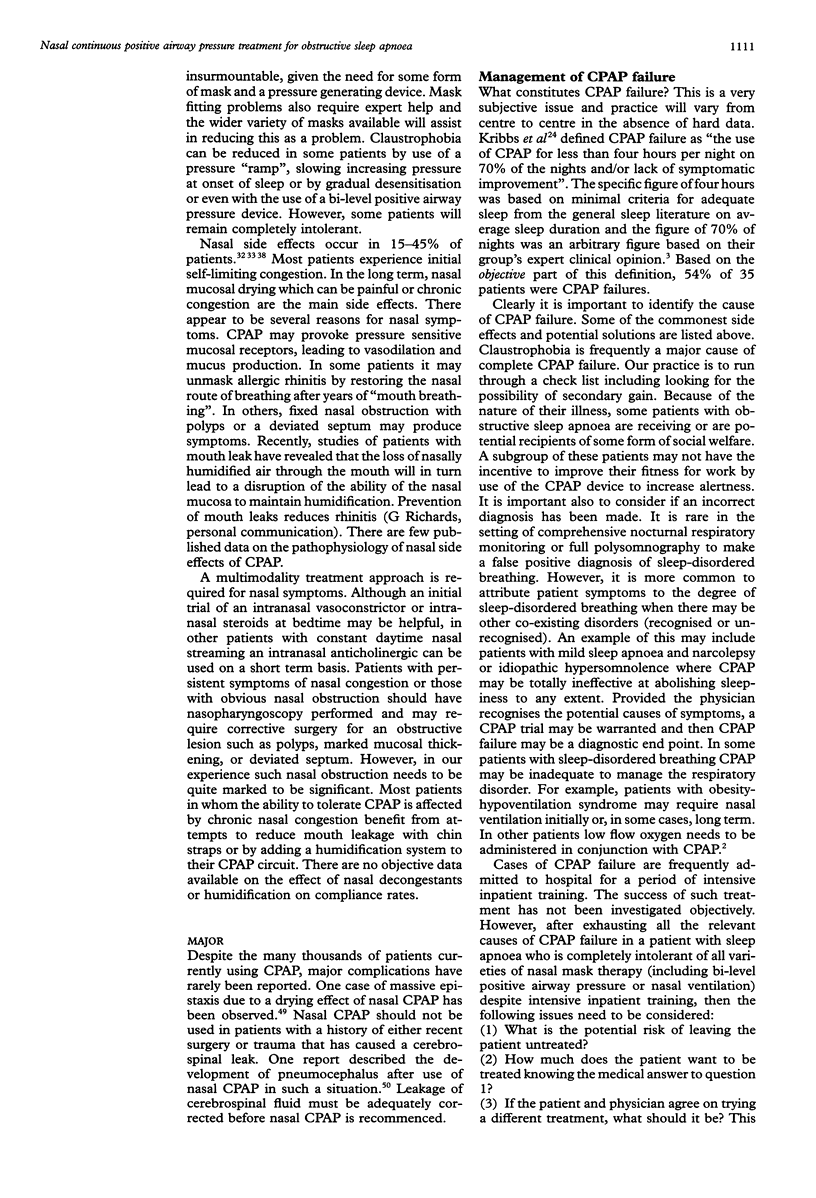
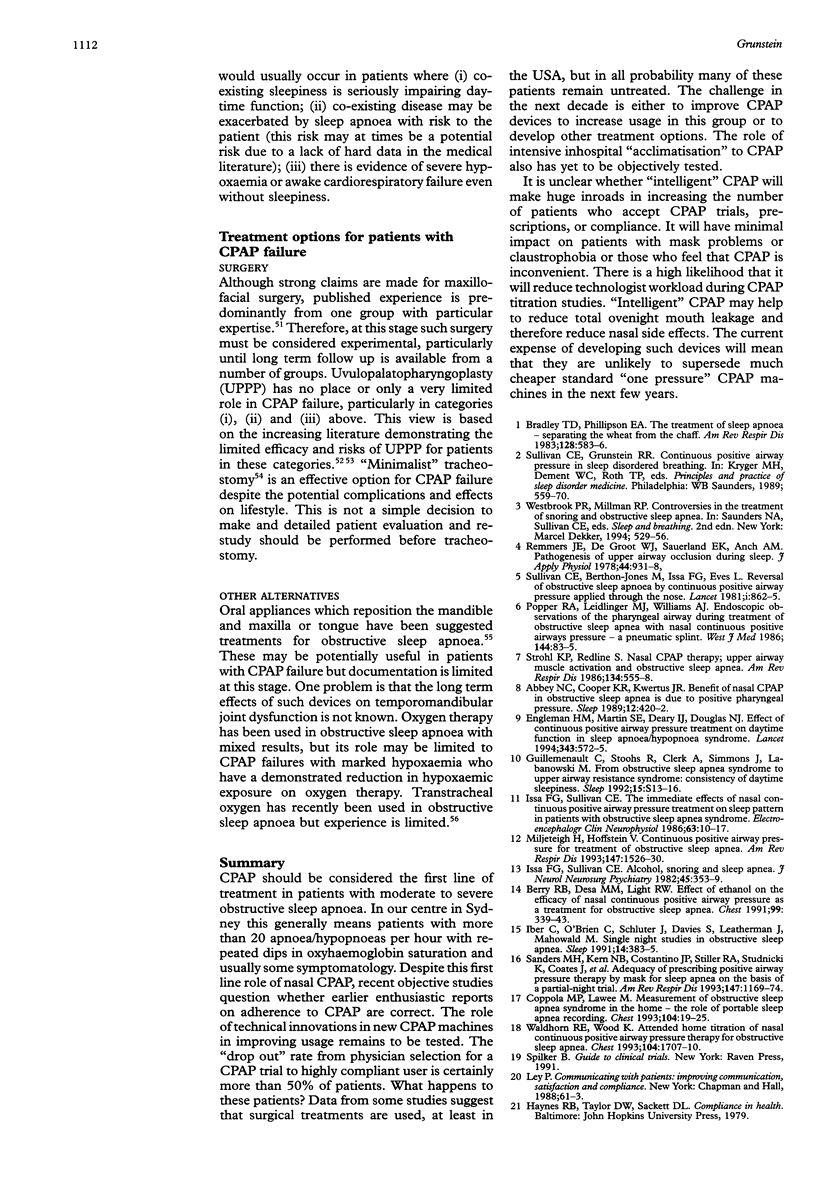
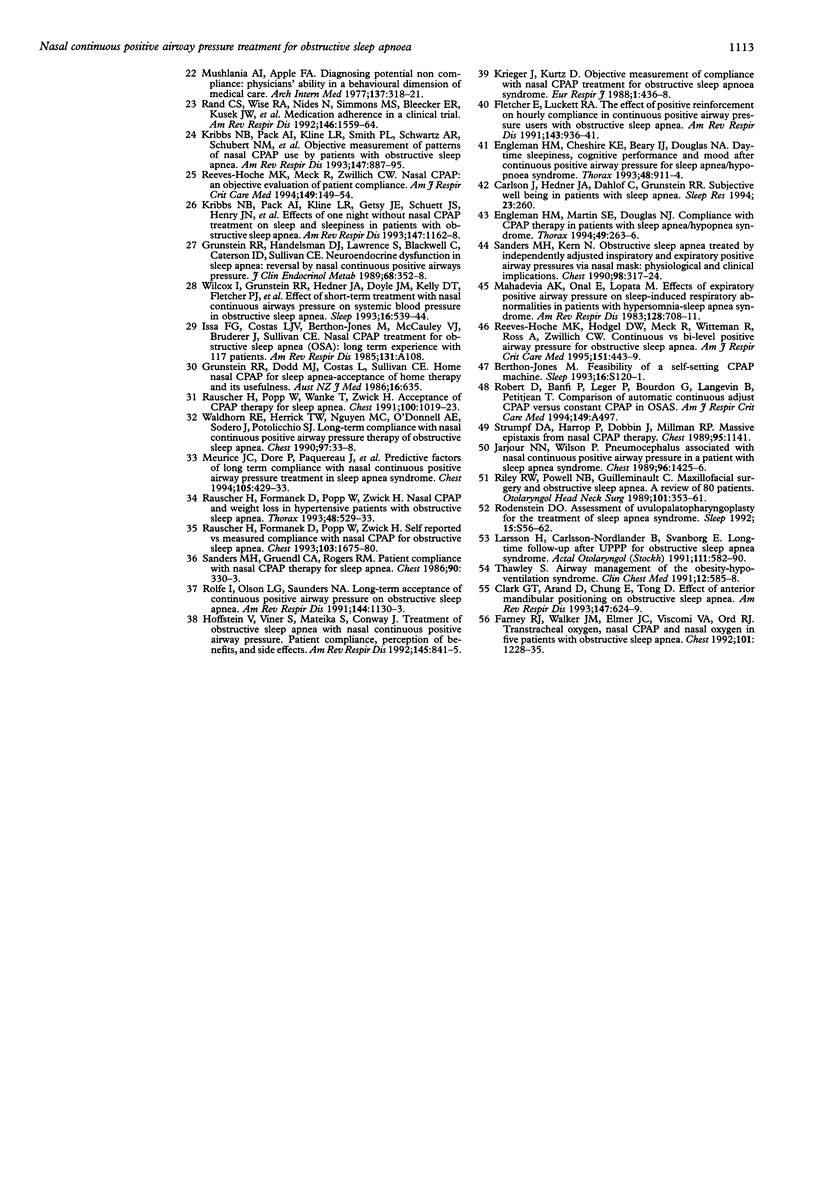
Selected References
These references are in PubMed. This may not be the complete list of references from this article.
- Abbey N. C., Cooper K. R., Kwentus J. A. Benefit of nasal CPAP in obstructive sleep apnea is due to positive pharyngeal pressure. Sleep. 1989 Oct;12(5):420–422. [PubMed] [Google Scholar]
- Berry R. B., Desa M. M., Light R. W. Effect of ethanol on the efficacy of nasal continuous positive airway pressure as a treatment for obstructive sleep apnea. Chest. 1991 Feb;99(2):339–343. doi: 10.1378/chest.99.2.339. [DOI] [PubMed] [Google Scholar]
- Berthon-Jones M. Feasibility of a self-setting CPAP machine. Sleep. 1993 Dec;16(8 Suppl):S120–S123. doi: 10.1093/sleep/16.suppl_8.s120. [DOI] [PubMed] [Google Scholar]
- Bradley D., Phillipson E. A. The treatment of obstructive sleep apnea. Separating the wheat from the chaff. Am Rev Respir Dis. 1983 Oct;128(4):583–586. doi: 10.1164/arrd.1983.128.4.583. [DOI] [PubMed] [Google Scholar]
- Clark G. T., Arand D., Chung E., Tong D. Effect of anterior mandibular positioning on obstructive sleep apnea. Am Rev Respir Dis. 1993 Mar;147(3):624–629. doi: 10.1164/ajrccm/147.3.624. [DOI] [PubMed] [Google Scholar]
- Coppola M. P., Lawee M. Management of obstructive sleep apnea syndrome in the home. The role of portable sleep apnea recording. Chest. 1993 Jul;104(1):19–25. doi: 10.1378/chest.104.1.19. [DOI] [PubMed] [Google Scholar]
- Engleman H. M., Cheshire K. E., Deary I. J., Douglas N. J. Daytime sleepiness, cognitive performance and mood after continuous positive airway pressure for the sleep apnoea/hypopnoea syndrome. Thorax. 1993 Sep;48(9):911–914. doi: 10.1136/thx.48.9.911. [DOI] [PMC free article] [PubMed] [Google Scholar]
- Engleman H. M., Martin S. E., Deary I. J., Douglas N. J. Effect of continuous positive airway pressure treatment on daytime function in sleep apnoea/hypopnoea syndrome. Lancet. 1994 Mar 5;343(8897):572–575. doi: 10.1016/s0140-6736(94)91522-9. [DOI] [PubMed] [Google Scholar]
- Engleman H. M., Martin S. E., Douglas N. J. Compliance with CPAP therapy in patients with the sleep apnoea/hypopnoea syndrome. Thorax. 1994 Mar;49(3):263–266. doi: 10.1136/thx.49.3.263. [DOI] [PMC free article] [PubMed] [Google Scholar]
- Farney R. J., Walker J. M., Elmer J. C., Viscomi V. A., Ord R. J. Transtracheal oxygen, nasal CPAP and nasal oxygen in five patients with obstructive sleep apnea. Chest. 1992 May;101(5):1228–1235. doi: 10.1378/chest.101.5.1228. [DOI] [PubMed] [Google Scholar]
- Fletcher E. C., Luckett R. A. The effect of positive reinforcement on hourly compliance in nasal continuous positive airway pressure users with obstructive sleep apnea. Am Rev Respir Dis. 1991 May;143(5 Pt 1):936–941. doi: 10.1164/ajrccm/143.5_Pt_1.936. [DOI] [PubMed] [Google Scholar]
- Grunstein R. R., Handelsman D. J., Lawrence S. J., Blackwell C., Caterson I. D., Sullivan C. E. Neuroendocrine dysfunction in sleep apnea: reversal by continuous positive airways pressure therapy. J Clin Endocrinol Metab. 1989 Feb;68(2):352–358. doi: 10.1210/jcem-68-2-352. [DOI] [PubMed] [Google Scholar]
- Guilleminault C., Stoohs R., Clerk A., Simmons J., Labanowski M. From obstructive sleep apnea syndrome to upper airway resistance syndrome: consistency of daytime sleepiness. Sleep. 1992 Dec;15(6 Suppl):S13–S16. [PubMed] [Google Scholar]
- Hoffstein V., Viner S., Mateika S., Conway J. Treatment of obstructive sleep apnea with nasal continuous positive airway pressure. Patient compliance, perception of benefits, and side effects. Am Rev Respir Dis. 1992 Apr;145(4 Pt 1):841–845. doi: 10.1164/ajrccm/145.4_Pt_1.841. [DOI] [PubMed] [Google Scholar]
- Iber C., O'Brien C., Schluter J., Davies S., Leatherman J., Mahowald M. Single night studies in obstructive sleep apnea. Sleep. 1991 Oct;14(5):383–385. [PubMed] [Google Scholar]
- Issa F. G., Sullivan C. E. Alcohol, snoring and sleep apnea. J Neurol Neurosurg Psychiatry. 1982 Apr;45(4):353–359. doi: 10.1136/jnnp.45.4.353. [DOI] [PMC free article] [PubMed] [Google Scholar]
- Issa F. G., Sullivan C. E. The immediate effects of nasal continuous positive airway pressure treatment on sleep pattern in patients with obstructive sleep apnea syndrome. Electroencephalogr Clin Neurophysiol. 1986 Jan;63(1):10–17. doi: 10.1016/0013-4694(86)90056-8. [DOI] [PubMed] [Google Scholar]
- Jarjour N. N., Wilson P. Pneumocephalus associated with nasal continuous positive airway pressure in a patient with sleep apnea syndrome. Chest. 1989 Dec;96(6):1425–1426. doi: 10.1378/chest.96.6.1425. [DOI] [PubMed] [Google Scholar]
- Kribbs N. B., Pack A. I., Kline L. R., Getsy J. E., Schuett J. S., Henry J. N., Maislin G., Dinges D. F. Effects of one night without nasal CPAP treatment on sleep and sleepiness in patients with obstructive sleep apnea. Am Rev Respir Dis. 1993 May;147(5):1162–1168. doi: 10.1164/ajrccm/147.5.1162. [DOI] [PubMed] [Google Scholar]
- Kribbs N. B., Pack A. I., Kline L. R., Smith P. L., Schwartz A. R., Schubert N. M., Redline S., Henry J. N., Getsy J. E., Dinges D. F. Objective measurement of patterns of nasal CPAP use by patients with obstructive sleep apnea. Am Rev Respir Dis. 1993 Apr;147(4):887–895. doi: 10.1164/ajrccm/147.4.887. [DOI] [PubMed] [Google Scholar]
- Krieger J., Kurtz D. Objective measurement of compliance with nasal CPAP treatment for obstructive sleep apnoea syndrome. Eur Respir J. 1988 May;1(5):436–438. [PubMed] [Google Scholar]
- Larsson H., Carlsson-Nordlander B., Svanborg E. Long-time follow-up after UPPP for obstructive sleep apnea syndrome. Results of sleep apnea recordings and subjective evaluation 6 months and 2 years after surgery. Acta Otolaryngol. 1991;111(3):582–590. doi: 10.3109/00016489109138387. [DOI] [PubMed] [Google Scholar]
- Mahadevia A. K., Onal E., Lopata M. Effects of expiratory positive airway pressure on sleep-induced respiratory abnormalities in patients with hypersomnia-sleep apnea syndrome. Am Rev Respir Dis. 1983 Oct;128(4):708–711. doi: 10.1164/arrd.1983.128.4.708. [DOI] [PubMed] [Google Scholar]
- McLear P. W., Thawley S. E. Airway management in obesity hypoventilation syndrome. Clin Chest Med. 1991 Sep;12(3):585–588. [PubMed] [Google Scholar]
- Meurice J. C., Dore P., Paquereau J., Neau J. P., Ingrand P., Chavagnat J. J., Patte F. Predictive factors of long-term compliance with nasal continuous positive airway pressure treatment in sleep apnea syndrome. Chest. 1994 Feb;105(2):429–433. doi: 10.1378/chest.105.2.429. [DOI] [PubMed] [Google Scholar]
- Miljeteig H., Hoffstein V. Determinants of continuous positive airway pressure level for treatment of obstructive sleep apnea. Am Rev Respir Dis. 1993 Jun;147(6 Pt 1):1526–1530. doi: 10.1164/ajrccm/147.6_Pt_1.1526. [DOI] [PubMed] [Google Scholar]
- Mushlin A. I., Appel F. A. Diagnosing potential noncompliance. Physicians' ability in a behavioral dimension of medical care. Arch Intern Med. 1977 Mar;137(3):318–321. doi: 10.1001/archinte.137.3.318. [DOI] [PubMed] [Google Scholar]
- Popper R. A., Leidinger M. J., Williams A. J. Endoscopic observations of the pharyngeal airway during treatment of obstructive sleep apnea with nasal continuous positive airway pressure--a pneumatic splint. West J Med. 1986 Jan;144(1):83–85. [PMC free article] [PubMed] [Google Scholar]
- Rand C. S., Wise R. A., Nides M., Simmons M. S., Bleecker E. R., Kusek J. W., Li V. C., Tashkin D. P. Metered-dose inhaler adherence in a clinical trial. Am Rev Respir Dis. 1992 Dec;146(6):1559–1564. doi: 10.1164/ajrccm/146.6.1559. [DOI] [PubMed] [Google Scholar]
- Rauscher H., Formanek D., Popp W., Zwick H. Nasal CPAP and weight loss in hypertensive patients with obstructive sleep apnoea. Thorax. 1993 May;48(5):529–533. doi: 10.1136/thx.48.5.529. [DOI] [PMC free article] [PubMed] [Google Scholar]
- Rauscher H., Formanek D., Popp W., Zwick H. Self-reported vs measured compliance with nasal CPAP for obstructive sleep apnea. Chest. 1993 Jun;103(6):1675–1680. doi: 10.1378/chest.103.6.1675. [DOI] [PubMed] [Google Scholar]
- Reeves-Hoche M. K., Meck R., Zwillich C. W. Nasal CPAP: an objective evaluation of patient compliance. Am J Respir Crit Care Med. 1994 Jan;149(1):149–154. doi: 10.1164/ajrccm.149.1.8111574. [DOI] [PubMed] [Google Scholar]
- Reeves-Hoché M. K., Hudgel D. W., Meck R., Witteman R., Ross A., Zwillich C. W. Continuous versus bilevel positive airway pressure for obstructive sleep apnea. Am J Respir Crit Care Med. 1995 Feb;151(2 Pt 1):443–449. doi: 10.1164/ajrccm.151.2.7842204. [DOI] [PubMed] [Google Scholar]
- Remmers J. E., deGroot W. J., Sauerland E. K., Anch A. M. Pathogenesis of upper airway occlusion during sleep. J Appl Physiol Respir Environ Exerc Physiol. 1978 Jun;44(6):931–938. doi: 10.1152/jappl.1978.44.6.931. [DOI] [PubMed] [Google Scholar]
- Riley R. W., Powell N. B., Guilleminault C. Maxillofacial surgery and obstructive sleep apnea: a review of 80 patients. Otolaryngol Head Neck Surg. 1989 Sep;101(3):353–361. doi: 10.1177/019459988910100309. [DOI] [PubMed] [Google Scholar]
- Rodenstein D. O. Assessment of uvulopalatopharyngoplasty for the treatment of sleep apnea syndrome. Sleep. 1992 Dec;15(6 Suppl):S56–S62. doi: 10.1093/sleep/15.suppl_6.s56. [DOI] [PubMed] [Google Scholar]
- Rolfe I., Olson L. G., Saunders N. A. Long-term acceptance of continuous positive airway pressure in obstructive sleep apnea. Am Rev Respir Dis. 1991 Nov;144(5):1130–1133. doi: 10.1164/ajrccm/144.5.1130. [DOI] [PubMed] [Google Scholar]
- Sanders M. H., Gruendl C. A., Rogers R. M. Patient compliance with nasal CPAP therapy for sleep apnea. Chest. 1986 Sep;90(3):330–333. doi: 10.1378/chest.90.3.330. [DOI] [PubMed] [Google Scholar]
- Sanders M. H., Kern N. B., Costantino J. P., Stiller R. A., Studnicki K., Coates J., Orris S., Schimerman S. Adequacy of prescribing positive airway pressure therapy by mask for sleep apnea on the basis of a partial-night trial. Am Rev Respir Dis. 1993 May;147(5):1169–1174. doi: 10.1164/ajrccm/147.5.1169. [DOI] [PubMed] [Google Scholar]
- Sanders M. H., Kern N. Obstructive sleep apnea treated by independently adjusted inspiratory and expiratory positive airway pressures via nasal mask. Physiologic and clinical implications. Chest. 1990 Aug;98(2):317–324. doi: 10.1378/chest.98.2.317. [DOI] [PubMed] [Google Scholar]
- Strohl K. P., Redline S. Nasal CPAP therapy, upper airway muscle activation, and obstructive sleep apnea. Am Rev Respir Dis. 1986 Sep;134(3):555–558. doi: 10.1164/arrd.1986.134.3.555. [DOI] [PubMed] [Google Scholar]
- Strumpf D. A., Harrop P., Dobbin J., Millman R. P. Massive epistaxis from nasal CPAP therapy. Chest. 1989 May;95(5):1141–1141. doi: 10.1378/chest.95.5.1141. [DOI] [PubMed] [Google Scholar]
- Sullivan C. E., Issa F. G., Berthon-Jones M., Eves L. Reversal of obstructive sleep apnoea by continuous positive airway pressure applied through the nares. Lancet. 1981 Apr 18;1(8225):862–865. doi: 10.1016/s0140-6736(81)92140-1. [DOI] [PubMed] [Google Scholar]
- Waldhorn R. E., Herrick T. W., Nguyen M. C., O'Donnell A. E., Sodero J., Potolicchio S. J. Long-term compliance with nasal continuous positive airway pressure therapy of obstructive sleep apnea. Chest. 1990 Jan;97(1):33–38. doi: 10.1378/chest.97.1.33. [DOI] [PubMed] [Google Scholar]
- Waldhorn R. E., Wood K. Attended home titration of nasal continuous positive airway pressure therapy for obstructive sleep apnea. Chest. 1993 Dec;104(6):1707–1710. doi: 10.1378/chest.104.6.1707. [DOI] [PubMed] [Google Scholar]
- Wilcox I., Grunstein R. R., Hedner J. A., Doyle J., Collins F. L., Fletcher P. J., Kelly D. T., Sullivan C. E. Effect of nasal continuous positive airway pressure during sleep on 24-hour blood pressure in obstructive sleep apnea. Sleep. 1993 Sep;16(6):539–544. doi: 10.1093/sleep/16.6.539. [DOI] [PubMed] [Google Scholar]


